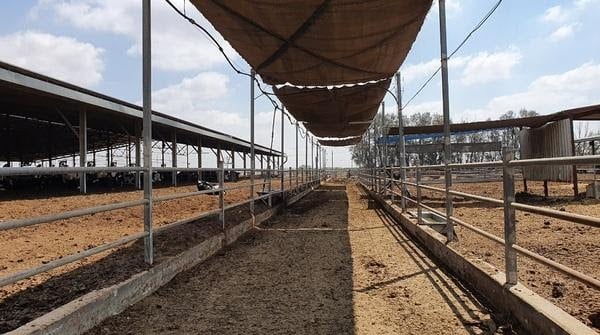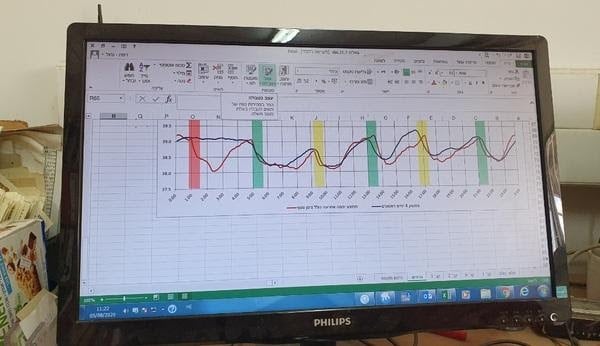Zeelim dairy farm is located in the south of Israel and characterized by desert conditions and low rainfall in winter (100-150 mm/year) November-March.
In the last years, recycled water from the big Tel Aviv metropolitan area reached the region by pipelines where fields are cultivated by crops and orchards. This changed dramatically Zeelim climate to much more humid nights and increased general THI. In recent summers, cows experienced heat stress conditions 24/7 for almost 5 months per year.
Farm housing consists of two big "compost barn" shades with open rigid in the roof, as well as old compost shades for heifers, dry and close up cows. The resting area for milking cows is about 20 square meters per cow under the roves. Summer yaomnirds area is not calculated in the space per cow. The sheds are well naturally ventilated and allow maintain barn bedding dry, almost all year, with one drilling regime per day.

The Zeelim dairy farm consists of 350 Holstein cows (315 cows in milk and 35 dry cows). The cows are milked 3 times per day (04:00, 12:00 and 20:00), with a duration of four hours for each milking session. Average per cow daily milk production during my visit (July 2020) was 46 kg (totaling 15,000 lit. per farm/day). Average per cow annual milk production in 2019 (corrected to 305 days) reached 14,785 kg and ranked number one in Israel this year (as well as the two previous years). Milk fat and protein averaged 3.80% and 3.40%, respectively, while milk Somatic Cells Content (SCC) was 180,000 units/ml.

Zeelim dairy farm feed cows with a Total Mixed Ration (TMR), distributed to the cows 3 times per day, when roughage is chopped and whey is add in time of mixing, in order to reach better mix dry matter (DM) content and palatability. Diet contains wheat and corn silages with added hay, as roughage sources, and corn grains, gluten feed, DDGS and rapeseed flour, as concentrated energy and protein sources. Average dry matter intake per cow reaches 31 kg in the winter and suffers just a small drop, to 29 kg, in the summer. Diet Concentrations are, 30% NDF, 1.77 Mcal NeL/kg, 17% Crude Protein and Mix dry matter of 60%.
Dealing with summer heat starts way before providing intensive cooling treatment to the cows. Walkways are shaded with plastic nets and water troughs present inside barns, along walkways and in waiting and cooling yards (an average of more than 30 cm of water troughs space per cow).

The waiting yard is divided into 3 sections (with a space of 2 square meters/cow). All the cows receive cooling treatment (combining wetting and forced ventilation) in the waiting and cooling yards, before each of the 3 milking sessions (a duration of 45 and 60 minutes of cooling treatment per group (fans operate continually and water for 30 seconds each 5 minutes). In addition, the cows are cooled for 2–3 times more in the waiting and cooling yards, between milking sessions, including night-time cooling (45 minutes/group).
Feedline Fans (20”, 6 meters apart), with 4 misters installed in front of each fan (4X14 lit./h), activated by “presence detecting sensors” and operate 24/7, with cycles of 30 seconds misting every 5 minutes. In total, cows in Zeelim dairy farm are cooled for more than 6 cumulative hours per day, in at least 6 cooling sessions.

In order to evaluate the effectiveness of cooling treatment, short term (monitoring cow's body temperature), and long term (using summer to winter ratio index), means are used.
Along the summer, intravaginal data loggers are inserted to a sample of cows in each group and cow's temperature is monitored in 15 minutes interval for 72 hours period. As can be seen in the graph picture, taken from the farm computer screen, the cows are capable to maintain normal body temperature (below 39.0 C), during all the studied period.

At the end of each year, the summer (July–September) to winter (January–March) ratio index is calculated, evaluating productive and reproductive traits. As can be seen in the table below, summer average per cow production and S:W ratio for milk and conception rates are presented for Zeelim dairy farm and compared to 18 neighboring farms from the southern region of the country and to 162 large scale dairy farms, from all over Israel.

As can be seen from the table above, Zeelim dairy farm reach impressing average milk production per cow in the summer and almost do not drop in milk production in the warm and humid months (S:W ratio of 0.99). These numbers are above those reached in the dairy farms from the southern region (considered highest producing region in the country), and much above the averages of the large scale farms in the entire country.
Asking Hagar, farm manager, what is your secret?, her answer is "we don't have secrets, we just pay attention to small as big details", we try to provide professional treatment in every stage of the production chain and, above all, our philosophy is to raise our cows with much love and care.
More information about Dr. Israel Flamenbaum and his expertise on: Cool-cows.com
Subscribe to our blog updates and receive new blog articles in your mailbox.
